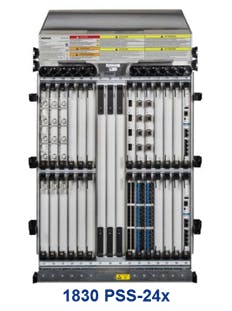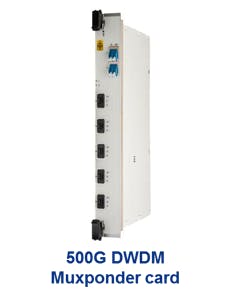Preparing Optical Networks for the 100G Services Era
Introduction
Communications service providers (CSPs) are under tremendous pressure to scale their networks to meet the continuously increasing bandwidth demands generated by mobile broadband, IP video, and the Internet of Things (IoT). From the perspective of the CSP optical transport network, these services represent an internal customer – CSP IP routers connecting to CSP transport. However, CSPs must also respond to the demands of external customers such as large businesses and internet content providers, who want high-bandwidth connectivity to cloud data centers and collocation facilities.
To meet internal and external demand for high-speed data services, CSPs must continually upgrade their networks to support higher transport capacities. Optical networks that once connected customers with 10G interfaces are rapidly being pushed to offer 100G interface connectivity together with variable data rates ranging from 10 Gb/s to 100 Gb/s.
The traditional approach for scaling optical networks is to increase the capacity of transport wavelengths – for example, from 40G to 100G or from 100G to 200G. However, this technique is rapidly approaching barriers defined by the laws of physics. To break through these barriers and keep up with demand, optical networks need better wavelengths. They also need more wavelengths and the ability to protect and fill these wavelengths more efficiently.
Optical network inflection point
This shift towards 100G interface connectivity to the transport network corresponds to an inflection point in the way optical networks are built. Prior to 2010, most transport networks were built around 10G technologies. They aggregated sub-10G services and provided transport to 10GigE and OC-192/STM-64 clients. Over the past five years, 100G coherent dense wavelength division multiplexing (DWDM) has been the key technological innovation driving scale in optical transport networks. New deployments almost exclusively use 100G transport.
IP routers are now the primary clients for transport services, and adoption of 100G router ports is rapidly accelerating. CSPs see an opportunity to help their customers (and themselves) scale their networks and grow their businesses by offering 100G services. To seize this opportunity, CSPs need to start thinking about transporting 100G services as if they are 10G services – that is, in large quantities and multiplexed into higher-rate transport wavelengths.
This change of approach requires a generational leap in optical network scale. It is still possible to transport 100G clients over 100G DWDM transport wavelengths, but this presents serious scale limitations, particularly where fiber is scarce. While 200G transport wavelengths are available, they come with distance limitations that confine their use to metro geographic areas.
Optimizing wavelength capacity and distance
A great deal of sophistication is required to wring as much bandwidth as possible from any given fiber span. The laws of physics that govern light transmission demand an intricate dance between capacity and distance. High-order modulation formats are vital for maximizing transport wavelength capacity. However, high-order modulation alone is not enough to meet the bandwidth demands being placed on optical networks.
Advances in high-order modulation can scale transport wavelengths for 100G services if they are augmented with technological innovation in areas such as increased baud rate, data stream coding and wavelength transmit filtering.
The Nokia Photonic Service Engine 2 Super Coherent (PSE-2s) digital processor implements leading-edge algorithms that tune these variables to increase transport wavelength capacity and transmission distance.
New wavelengths for maximizing network scale, efficiency and flexibility
The PSE-2s supports a wide range of unique transport wavelengths including:
- Extended 200G wavelength distances for the long-haul environment from 800 km to 2,000 km with 8-QAM at 44 GBaud. This modulation format reduces deployment complexity and offers the best alignment with 100GE router/switch interface rates.
- Increased 100G wavelength distances from 3,000 km to more than 5,000 km through the use of a novel 4-Dimensional Set Partitioned QPSK (4D-SP-QPSK) modulation format. This format supports unregenerated transcontinental reach, including direct connect to subsea networks.
- The industry’s first 400G single-carrier wavelength. Leveraging 64-QAM, this mode results in the highest capacity per fiber available today, at 35.2 Tb/s.
- Increased 500G superchannel distance with the first two-carrier 500G superchannel to address both metro and regional distances. This superchannel combines leading spectral efficiency with leading service port density.
These new transport wavelengths can effectively double the capacity of existing optical networks over both metro and long-haul distances.
Going beyond better wavelengths
Even with a doubling of network capacity, many CSPs will be looking for more optical network scale in the near term. The ultimate approach for addressing this scaling need will be to deploy solutions based on space-division multiplexing (SDM). Research is well underway in this area but SDM-related products are not expected to reach the market for some time. This makes SDM a longer-term network scaling tool. Optical network operators will have to use other approaches to scale network capacity in the near term.
More wavelengths
Due to certain physics limitations, fiber networks are constrained by the number of individual wavelengths they can support and the data rate that each wavelength can support. Existing fiber-optic networks operate in what’s known as the C-band, which typically supports up to 96 channels. Once a CSP fills all 96 channels of the C-band, it faces the daunting and expensive task of overbuilding its entire optical route on a new pair of fibers.
One option for adding capacity is to use flexible grid WDM systems, which support channel sizes as small as 37.5 GHz. The smaller channel size provides up to 120 channels in the C-band. But there are trade-offs: as channel spacing decreases, the transport wavelength distance also decreases. The smaller-sized channels fit better on metro networks than on long-haul routes.
Use of L-band (1565 nm to 1625 nm) wavelength frequencies is an alternative that provides additional capacity for all distance requirements. The L-band shares many characteristics with the C-band, including low fiber loss and the availability of erbium-doped fiber amplifier (EDFA) technology for amplification.
The Nokia Ultra-Wideband CDC-F Wavelength Routing solution doubles the number of wavelengths and the capacity that each optical network fiber can support. This solution enables CSPs to use both C-band and L-band optical frequencies, giving them access to up to 192 wavelengths per fiber.
CSPs can deploy C-band transponders to meet their initial requirements, and then add L-band capacity as needed in the future. No changes or upgrades are required to the core C-band reconfigurable optical add drop multiplexer (ROADM) or in-line amplifier (ILA) nodes. This reduces operating costs and eliminates network disruptions. When additional L-band capacity is required, CSPs can simply deploy L-band-specific drop modules and transponders where they are needed.
More efficient wavelengths
Another approach for scaling network capacity is to optimally pack transport wavelengths with services. CSPs can do this by using scaled-up packet/optical transport network (OTN) switching and 100G service multiplexing to efficiently pack and protect transport wavelengths.
For CSPs that leverage packet/OTN switching in their networks, this approach involves packing as much packet/OTN switching as possible into a single rack, while also using much less power. For CSPs with non-OTN networks, the approach involves packing as many 100G services as possible into compact DWDM muxponder cards.
The Nokia 1830 PSS-24x packet/OTN platform allows CSPs to place large-scale packet/OTN switching at international/national, regional, and metro core optical network locations. It supports a new level of switching scale by combining intelligent electrical fabric design, transport wavelength cards powered by the PSE-2s, and services cards that provide high client port density.
The Nokia 500G DWDM Muxponder card also incorporates PSE-2s technology. It supports up to five 100GE clients, PSE-2s transport wavelength throughput from 100G to 500G, and reach from metro to subsea. With just one card, CSPs get the performance and flexibility they need to deploy 100G services throughout the network. This single-card flexibility also simplifies spares inventory and wavelength protection.
Summary
CSPs need to prepare their networks for 100G service connectivity and the corresponding demands for more bandwidth. To keep up they need better wavelengths, more wavelengths, and more efficient wavelengths.
CSPs can address these requirements using equipment that incorporates next-generation coherent digital signal processors, CDC-F wavelength routing that supports the C- and L-bands, large scale packet/OTN switching, and efficient 100G service multiplexing.
Together, these capabilities can scale network capacity by a factor of four while making networks more flexible and efficient. They provide a near-term solution that will enable CSPs to scale networks for 100G service delivery as they await SDM technologies that can address longer-term network scaling requirements.
To learn more about these solutions, please visit http://networks.nokia.com/portfolio/products/pse-2



